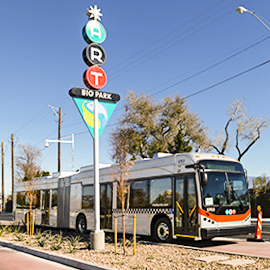
HDR-designed Albuquerque Rapid Transit system. Photo courtesy of HDR.

HDR-designed Albuquerque Rapid Transit system. Photo courtesy of HDR.
An HDR-designed bus rapid transit system in Albuquerque, New Mexico, opened for service on Nov. 25, becoming the first in the United States to meet the Gold BRT Standard from the Institute for Transportation & Development Policy. The gold certification represents the highest internationally recognized standard for BRT systems, according to HDR’s website.
Albuquerque Rapid Transit is owned and operated by the city’s transit department, ABQ RIDE. It is the first form of urban transit in the city of 560,000 to use a dedicated guideway. The project was delivered using the Construction Manager at Risk model of alternative delivery, and is on budget at a projected cost of $133.6 million.
Nicknamed ART, the new system includes 19 level-boarding transit stations — four curb side and 15 in the median — and addresses service deficiencies in one of the city’s most congested corridors: Central Avenue. “We wanted to help ABQ Ride improve mobility for all while offering a world-class transit experience,” said David Leard, HDR program manager. “The city’s commitment and vision, combined with community participation and support, made it possible to deliver a BRT system that exceeded all objectives.”
Along Central Avenue, some 14,000 transit users per day previously boarded both traditional buses and curb side, mixed-flow BRT, accounting for about 40 percent of all transit users in the city. But growing ridership and slow boarding procedures had combined with traffic to reduce on-time performance to unreliable levels.
HDR’s design is a first among BRT systems in the United States. It created dedicated right of way in each direction for 97 percent of the guideway using signals and sidings to coordinate bi-directional travel on a single lane for short distances. This concept borrows from freight rail and rail transit infrastructure designs.
About 16 miles of sidewalks were replaced or upgraded as part of the project, and new landscaping and pedestrian lighting added signature aesthetic features throughout the corridor. The project also replaced and upgraded signalization at 39 intersections to give priority to BRT vehicles.
“Like many growing cities, Albuquerque wanted a trusted partner and a custom, cost-effective transit solution,” said HDR Transit Director Tom Waldron. “We were happy to be selected to assemble the right team of planners, engineers, economists and other specialists to develop the first bus rapid transit system in the United States that meets the stringent gold standard.”
